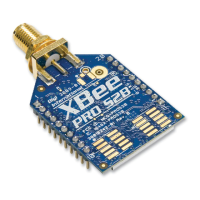Managing End Devices XBee ZB Router/Coordinator configuration
XBee/XBee-PRO ZigBee RF Modules User Guide 98
request will send a rejoin response if it can allow the device to join the network (i.e. child table not full). The rejoin
mechanism can be used to allow a device to join the same network even if permit-joining is disabled.
To enable rejoining, NJ should be set less than 0xFF on the device that will join. If NJ < 0xFF, the device assumes
the network is not allowing joining and first tries to join a network using rejoining. If multiple rejoining attempts
fail, or if NJ=0xFF, the device will attempt to join using association.
XBee ZB Router/Coordinator configuration
XBee routers and coordinators may require some configuration to ensure the following are set correctly:
RF packet buffering timeout
Child poll timeout
Transmission timeout.
The value of these timeouts depends on the sleep time used by the end devices. Each of these timeouts are
discussed below.
RF packet buffering timeout
When a router or coordinator receives an RF data packet intended for one of its end device children, it buffers the
packet until the end device wakes and polls for the data, or until a packet buffering timeout occurs. This timeout
is settable using the SP command. The actual timeout is (1.2 * SP), with a minimum timeout of 1.2 seconds and a
maximum of 30 seconds. Since the packet buffering timeout is set slightly larger than the SP setting, SP should be
set the same on routers and coordinators as it is on cyclic sleep end devices. For pin sleep devices, SP should be
set as long as the pin sleep device can sleep, up to 30 seconds.
Note: In pin sleep and extended cyclic sleep, end devices can sleep longer than 30 seconds. If end devices sleep
longer than 30 seconds, parent and non-parent devices must know when the end device is awake in order to
reliably send data. For applications that require sleeping longer than 30 seconds, end devices should transmit an
IO sample or other data when they wake to alert other devices that they can send data to the end device.
Child poll timeout
Router and coordinator devices maintain a timestamp for each end device child indicating when the end device
sent its last poll request to check for buffered data packets. If an end device does not send a poll request to its
parent for a certain period of time, the parent will assume the end device has moved out of range and will remove
the end device from its child table. This allows routers and coordinators to be responsive to changing network
conditions. The NC command can be issued at any time to read the number of remaining (unused) child table
entries on a router or coordinator.
The child poll timeout is settable with the SP and SN commands. SP and SN should be set such that SP * SN
matches the longest expected sleep time of any end devices in the network. The actual timeout is calculated as (3
* SP * SN), with a minimum of 5 seconds. For networks consisting of pin sleep end devices, the SP and SN values
on the coordinator and routers should be set such that SP * SN matches the longest expected sleep period of any
pin sleep device. The 3 multiplier ensures the end device will not be removed unless 3 sleep cycles pass without
receiving a poll request. The poll timeout is settable up to a couple of months.

